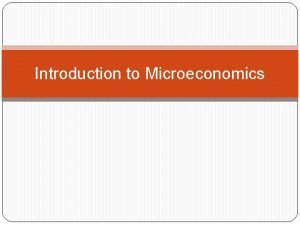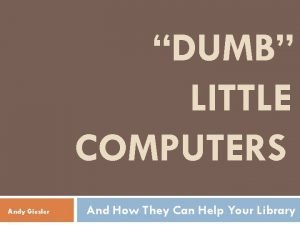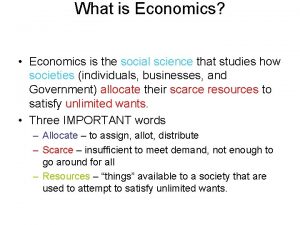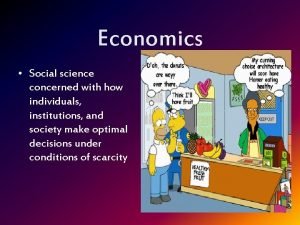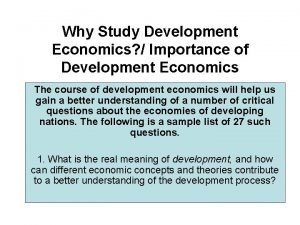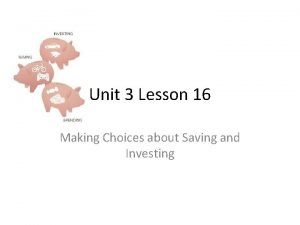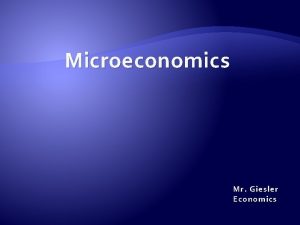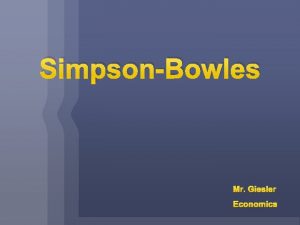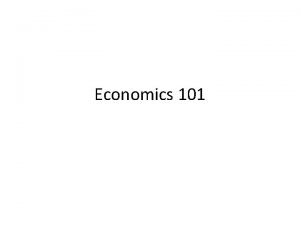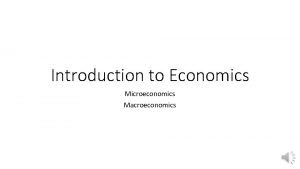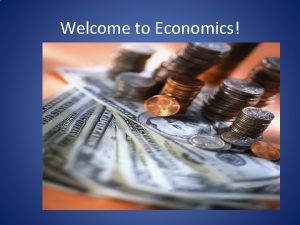Microeconomics Mr Giesler Economics Why Microeconomics Is Important




















- Slides: 20

Microeconomics Mr. Giesler Economics

Why Microeconomics Is Important At a Business and Professional Level q Imagine for a moment that you are a small business owner q Questions and Concerns that you will have q How can my firm minimize its costs and increase its profits? q What prices should I charge for my products? q Should I invest in new plant and equipment? q How should I respond to an aggressive strategic move by one of my competitors

Why Microeconomics Is Important At a Business and Professional Level From A Personal Level (as a student) q How can I maximize my grade point average given my time constraints? q Will I really be better off financially if I quit my job now and go back for an MBA degree? q What kind of career should I be preparing myself for? q What about that new refrigerator or automobile I want to buy--should I get the new, energy-efficient one?

What Is Microeconomics? q The word micro means small, and microeconomics focuses on the behavior of individual markets and the smaller individual units that make up the broader economy -- businesses, consumers, investors, and workers. q Microeconomics is distinguished from macroeconomics which focuses on problems in the broader economy like inflation and unemployment and the rate of economic growth.

What Is Microeconomics? q Adam Smith – the father of microeconomics q In The Wealth of Nations (1776), Smith considered how Individual prices are set, studied the determination of prices for land, labor, and capital, and examined the strengths and weaknesses of the free market mechanism.

The Invisible Hand q Adam Smith identified the remarkable efficiency properties of perfectly competitive markets. q Using his “invisible hand” analogy, Smith argued that the self-interested actions of individuals actually guide market outcomes to yield great economic benefits for the broader society TTYN: Think of an example of the “Invisible Hand” theory

The Invisible Hand TTYN: Think of an example of the “Invisible Hand” theory q Example, recognizing a need that kids are not doing enough tweeting, I would like to go into the cell phone, and therefore would enter some kind of industry related to cell phones. Instead of the government (for example, a mandated quota) or custom dictating the best use of my resources, I would direct my resources based on competitive sense of supply and demand of cell phones.

A Mixed Economy q Adam Smith had a vision of a perfectly competitive marketplace delivering goods and services at lowest price and highest quality. q The U. S. , as well as most other modern industrialized nations, has what is called a mixed economy. q At one end of this mixed economy, we have industries like farming and mining.

A Mixed Economy q These industries are characterized by many buyers and sellers and come closest to approximating Adam Smith's model of perfect competition. q At the other end, we have government involvement, which, historically has caused enduring debates of gov’t involvement regarding the private and public sectors

q The American free enterprise system emphasizes private ownership. q Private businesses produce most goods and services, and almost two-thirds of the nation's total economic output goes to individuals for personal use (the remaining one-third is bought by government and business). q The consumer role is so great, in fact, that the nation is sometimes characterized as having a "consumer economy. “

TTYN: Americans generally believe that an economy characterized by private ownership is likely to operate more efficiently than one with substantial government ownership. WHY? q When economic forces are unfettered, Americans believe, supply and demand determine the prices of goods and services. Prices, in turn, tell businesses what to produce; if people want more of a particular good than the economy is producing, the price of the good rises. In response, other companies increase production of that particular product. What happens next?

Pure Monopoly

Pure monopoly exists when a single firm is the sole producer of a product for which there are no close substitutes. TTYN: Can you identify a local utility company or sports franchise that may be an example of this? Examples are public utilities and professional sports leagues Characteristics 1. A single seller: the firm and industry are synonymous. 2. Unique product: no close substitutes for the firm’s product. 3. The firm is the price maker: the firm has considerable control over the price because it can control the quantity supplied. 4. Entry or exit is blocked.

Oligopoly

q Oligopolies are industries which typically have a small number of large firms. q Many of America’s largest industries are oligopolies much more likely to engage in collusive practices such as price fixing than the type of fierce competition envisioned by Adam Smith. q The degree of market concentration is very high. Firms within an oligopoly produce branded products (advertising and marketing is an important feature of competition within such markets) and there also barriers to entry.

q Another important characteristic of an oligopoly is interdependence between firms. This means that each firm must take into account the likely reactions of other firms in the market when making pricing and investment decisions. This creates uncertainty in such markets - which economists seek to model through the use of game theory.

A Command Economy q The government makes all the important decisions about production and distribution. q The government owns most of the means of production (land capital). q It also owns and directs the operations of enterprises in most industries.

A Command Economy q It is the employer of most workers and tells them how to do their jobs. q. And it decides how the output of the society is to be divided among different goods and services. TTYN: Identify several countries that would be considered Command Economies. Are there limitations or obvious problems with a command economy?

Three Questions -- Three Facets q. What shall be produced? q. How shall it be produced? q. For whom shall it be produced for?

Three Questions -- Three Facets Scarcity q Efficiency q Equity q TTYN: Describe Scarcity q If infinite quantities of every good could be produced, there would not be economic goods--goods that are scarce or limited in supply. q All goods would be free, like sand in the desert or seawater at the beach.
 Meaning
Meaning Hey hey bye bye
Hey hey bye bye Cold opposite warm same
Cold opposite warm same Melanie giesler
Melanie giesler Melanie giesler
Melanie giesler Markus giesler
Markus giesler Bill giesler
Bill giesler Andy giesler
Andy giesler Don't ask why why why
Don't ask why why why Maastricht university economics and business economics
Maastricht university economics and business economics What is mathematical economics
What is mathematical economics From most important to least important in writing
From most important to least important in writing From most important to least important in writing
From most important to least important in writing Least important to most important
Least important to most important What is economics in social science
What is economics in social science What is economics in social science
What is economics in social science Importance of development economics
Importance of development economics Guided reading activity 6 1 why save economics answers
Guided reading activity 6 1 why save economics answers Why is the resurrection important gcse
Why is the resurrection important gcse What is the footwork rule in netball
What is the footwork rule in netball Why is communication important in the workplace
Why is communication important in the workplace
